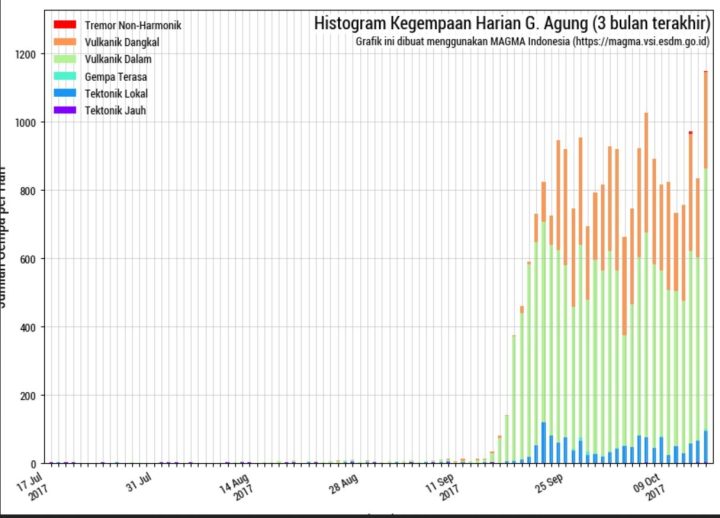Agung Volcano On The Verge Of Blowing…Major Eruption Would Have Impact On Earth’s Climate
By P Gosselin
Volcano Agung in Bali is showing worrisome signs of a major eruption, writes German climate blogger Schneefan here. The highest level of activity with multiple tremor episodes were just recorded. You can monitor Agung via live cam and live seismogram.
The 3000-mter tall Agung has been at the highest warning level 4 since September 21.
Schneefan writes that the lava rise has started and that “an eruption can be expected at any time“.
So far some 140,000 people have been evacuated from the area of hazard, which extends up to 12 km from the volcano. Schneefan writes:
Yesterday ground activity by far exceeded the previous high level. Quakes have become more frequent and stronger, which indicates a stronger magma flow (see green in the histogram). Since October 13 there has been for the first time a “nonharmonic trembling (tremor), which can be seen in red at the top of the last two bars of the histogram.”
The colors of the columns in the bar chart from bottom to top stand for perceptible earthquakes (blue) low eartnhquakes (green) surface quakes (orange . Just recently red appeared, signifying non harmonic tremors. The seismogram below shows what are at times longer period quakes: meaning magma is violently flowing in the volcano. Source: https://magma.vsi.esdm.go.id/.
Since yesterday the seismogram for AGUNG has been showing powerful rumbling (red).
The seismogram of AGUNG shows powerful tremors (level RED). The seismogram is updated every 3 minutes: Source: Seismogramm
Because Agung is located near the equator, a major eruption with ash flying up into the stratosphere would have short-term climatic impacts that could last a few years.
Agung last erupted in 1963 with an explosivity index of VEI 5, sending a plume of ash some 25 km into the atmosphere before leading to a cooling of 0.5°C. The eruption of Pinatubo in the Philippines in 1991 led to a global cooling of 0.5°C.




